The AMD Trinity Review (A10-4600M): A New Hope
by Jarred Walton on May 15, 2012 12:00 AM ESTAMD Trinity General Performance
Starting as usual with our general performance assessment, we’ve got several Futuremark benchmarks along with Cinebench and x264 HD encoding. The latter two focus specifically on stressing the CPU while PCMarks will cover most areas of system performance (including a large emphasis on storage) and 3DMarks will give us a hint at graphics performance. First up, PCMark 7 and Vantage:
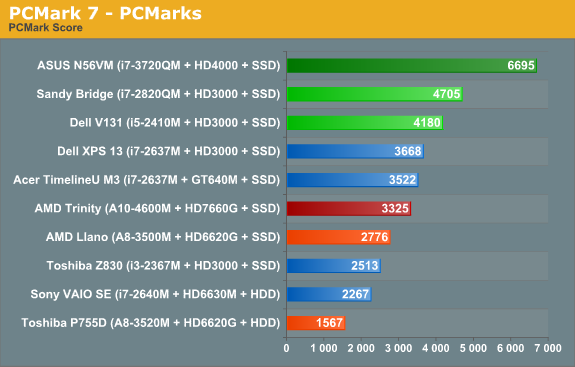
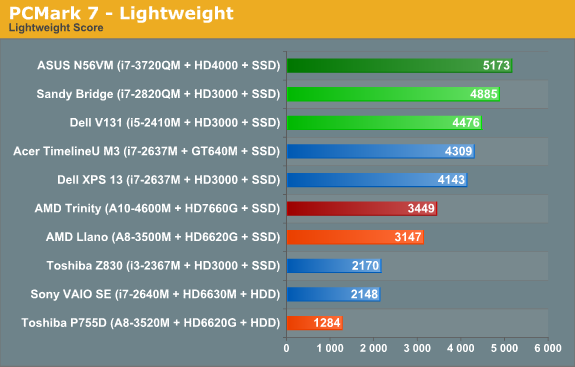
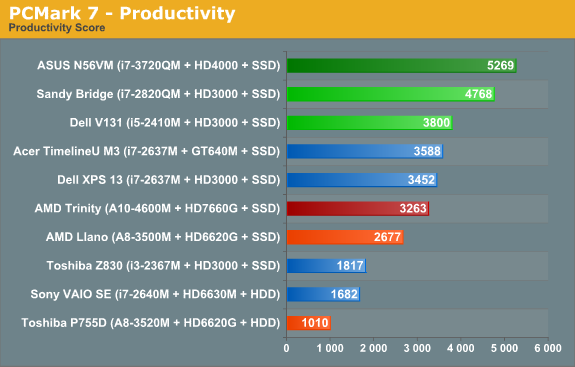

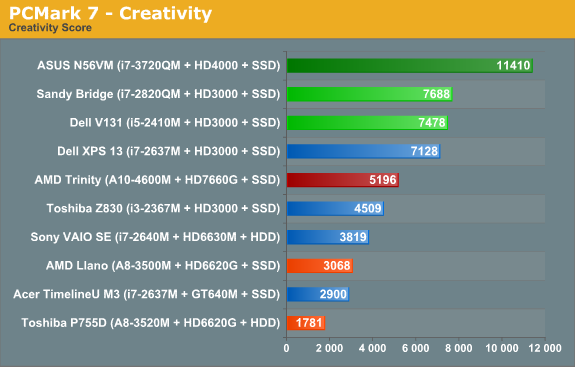
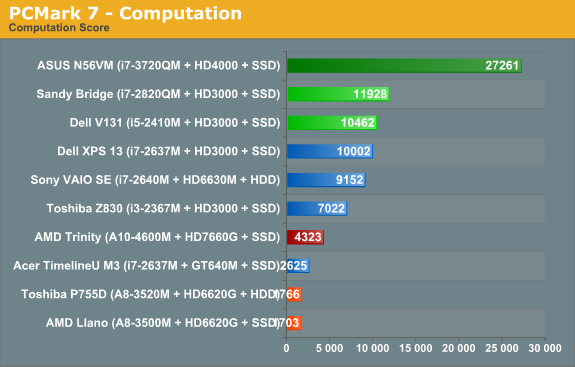
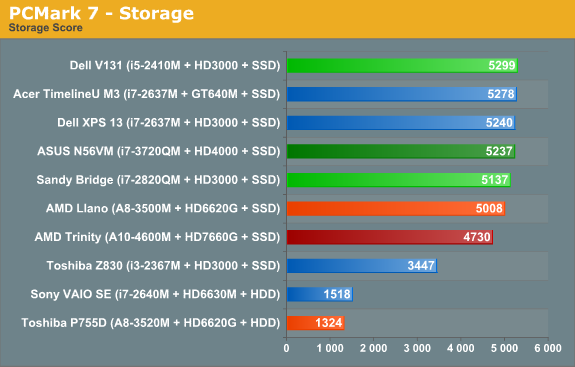
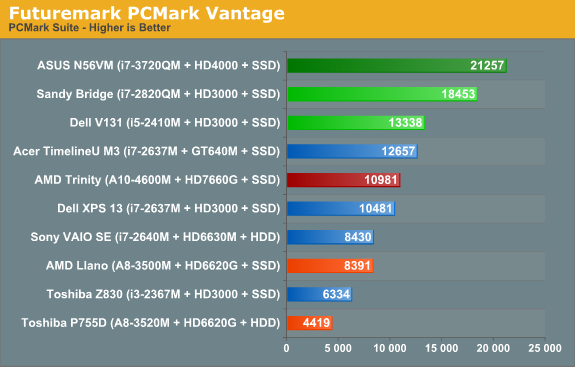
As noted earlier, we ran several other laptops through PCMark 7 and PCMark Vantage testing using the same Intel 520 240GB SSD, plus all the ultrabooks come with SSDs. That removes the SSD as a factor from most of the PCMark comparisons, leaving the rest of the platform to sink or swim on its own. And just how does AMD Trinity do here? Honestly, it’s not too bad, despite positioning within the charts.
Obviously, Intel’s quad-core Ivy Bridge is a beast when it comes to performance, but it’s a 45W beast that costs over $300 just for the CPU. We’ll have to wait for dual-core Ivy Bridge to see exactly how Intel’s latest stacks up against AMD, but if you remember the Llano vs. Sandy Bridge comparisons it looks like we’re in for more of the same. Intel continues to offer superior CPU performance, and even their Sandy Bridge ULV processors can often surpass Llano and Trinity. In the overall PCMark 7 metric, Trinity ends up being 20% faster than a Llano A8-3500M laptop, while Intel’s midrange i5-2410M posts a similar 25% lead on Trinity. Outside of the SSD, we’d expect Trinity and the Vostro V131 to both sell for around $600 as equipped.
A 25% lead for Intel is pretty big, but what you don’t necessarily get from the charts is that for many users, it just doesn’t matter. I know plenty of people using older Core 2 Duo (and even a few Core Duo!) laptops, and for general office tasks and Internet surfing they’re fine. Llano was already faster in general use than Core 2 Duo and Athlon X2 class hardware, and it delivered great battery life. Trinity boosts performance and [spoiler alert!] battery life, so it’s a net win. If you’re looking for a mobile workstation or something to do some hardcore gaming, Trinity won’t cut it—you’d want a quad-core Intel CPU for the former, and something with a discrete GPU for the latter—but for everything else, we’re in the very broad category known as “good enough”.


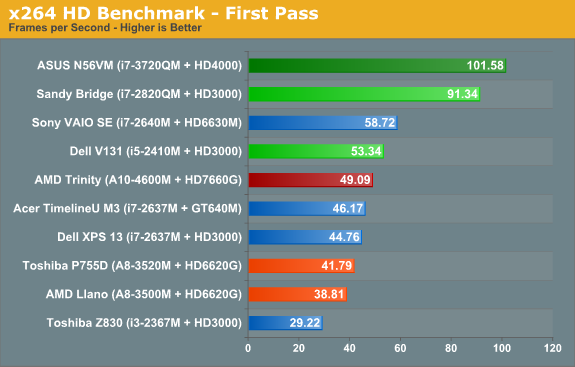
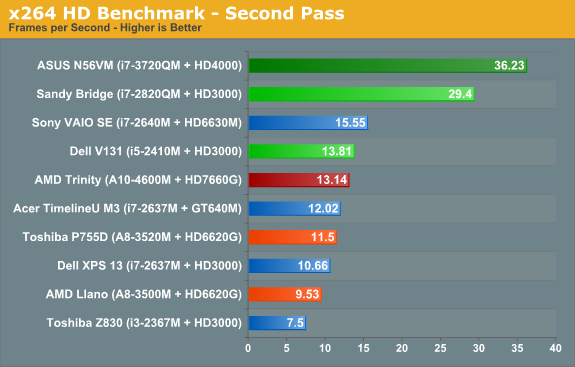
When we start drilling down into other performance metrics, AMD’s CPU performance deficiency becomes pretty obvious. The Cinebench single-threaded score is up 15% from 35W Llano, but in a bit of a surprise the multi-threaded score is basically a wash. Turn to the x264 HD encoding test however and Trinity once again shows a decent 15% improvement over Llano. Against Sandy Bridge and Ivy Bridge, though? AMD’s Trinity doesn’t stand a chance: i5-2410M is 50% faster in single-threaded Cinebench, 27% faster in multi-threaded, and 5-10% faster in x264. It’s a good thing 99.99% of laptop users never actually run applications like Cinebench for “real work”, but if you want to do video encoding a 10% increase can be very noticeable.

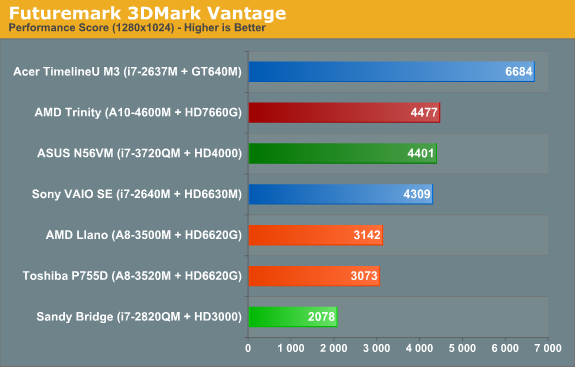
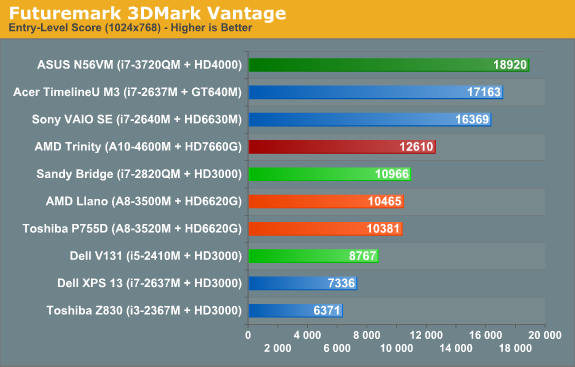
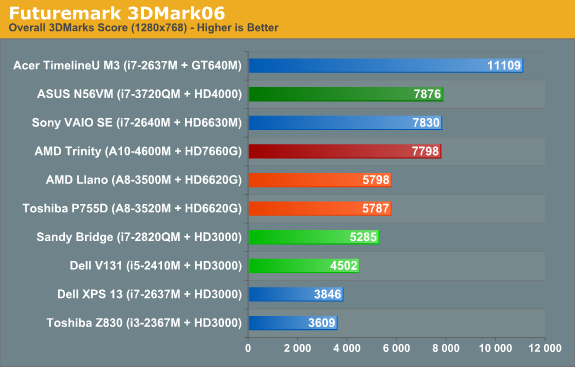
Shift over to graphics oriented benchmarks and the tables turn once again...sort of. Sandy Bridge can’t run 3DMark11, since it only has a DX10 class GPU, but in Vantage Performance and 3DMark06 Trinity is more than twice as fast as HD 3000. Of course, Ivy Bridge’s HD 4000 is the new Intel IGP Sheriff around these parts, and interestingly we see Trinity and i7-3720QM basically tied in these two synthetics. (We’ll just ignore 3DMark Vantage’s Entry benchmark, as it’s so light on graphics quality that we’ve found it doesn’t really stress most GPUs much—even low-end GPUs like HD 3000 score quite well.) We’ll dig into graphics performance more with our gaming benchmarks next.










271 Comments
View All Comments
AlB80 - Tuesday, May 15, 2012 - link
No.It's official information.
JarredWalton - Tuesday, May 15, 2012 - link
Except according to CLInfo, it does. Nice try?AlB80 - Tuesday, May 15, 2012 - link
Oops. It was.Now it has fp64 = 1/16 fp32.
princehamlet - Tuesday, May 15, 2012 - link
I was constantly refreshing the page at 12 AM! Couldn't wait for the reviews to be posted after the embargo was lifted :D.BSMonitor - Tuesday, May 15, 2012 - link
Why? Nothing earthshattering here. AMD is scalping resources from the CPU to add TDP room and die space for more of it's bulky Radeon shaders.It's like buying a laptop from 2004, with a DX11 upgrade.
AMD has the "good enough" part backwards. People want their laptop to be responsive when doing work, watching movies and browsing, etc. CPU intensive tasks. The good enough part, in regards to laptops would be the gaming. No one expects 60fps at 1080 out of laptop sitting on a plane flying somewhere.
Way to capture the hearts of the 1% of the 1% of people looking for great gaming from their $500 laptop.
Articuno - Tuesday, May 15, 2012 - link
Considering the CPU part is better than mobile Core 2 Duo parts (and thousands upon thousands of people are still using laptops with C2Ds) and the GPU part is several orders of magnitude better than Intel's best, I'd say buying an Intel laptop is like buying a laptop from 2004: expensive and extremely low price/performance for what you get.JarredWalton - Tuesday, May 15, 2012 - link
Whoa... several orders of magnitude? So, like, 1000X better? Because if anyone can offer up a GPU that's 1000 times faster than even GMA 4500, I'd take it! Turning down the hyperbole dial: AMD still has better drivers than Intel, but it's more like 20% better (just to grab a nice number out of thin air). Trinity's GPU is about 20% faster than HD 4000 as well, so that makes Trinity's GPU a whopping 44% better than "Intel's best".Now if you want to talk about the best Core 2 era IGP, then we'd be looking at more like an order of magnitude improvement. GMA 4500MHD scores around 1000 in 3DMark06, in case you were wondering (http://www.anandtech.com/show/2818/6). I know, it's only 3DMark -- still, call it 500 as a penalty for lousy drivers and HD 7660G is still "only" about 20X better.
/meaningless debate
Articuno - Tuesday, May 15, 2012 - link
Fair enough, kind of a knee-jerk reaction out of me there. Though I'm guessing the APU will be cheaper than the i7s it's going up against even without a discrete card added on top of them, so it's got very nice price/performance potential.jensend - Tuesday, May 15, 2012 - link
Yes, his "orders of magnitude" was hyperbole- but Intel's benchmark scores esp 3dmark really haven't reflected how awful their GPUs have been. The performance difference in real games was usually much bigger than that in synthetic benchmarks. You already mentioned driver issues. Even if you could get halfway decent performance out of some games, image quality was often a huge problem. If AMD or nV had offered that crappy of image quality they would have been totally excoriated in the press for cheating in order to inflate benchmarks; people didn't do that to Intel- probably because it would have felt like beating a handicapped child.But Sandy had some real improvements and then Ivy Bridge really turned things around for Intel. Beyond the performance improvements, after years of making excuses for their AF and saying that AA was unnecessary, they finally stopped making excuses and fixed them. Trinity is faster, but anybody who says that Ivy Bridge's graphics don't offer Trinity's any competition is badly mistaken.
Spunjji - Tuesday, May 15, 2012 - link
Indeed - I was honestly pleasantly surprised to see HD4000 sitting so high in the charts. Finally I won't need to start warning people against Intel notebooks!...except for the small problem of HD2500. Still, improvement is improvement.